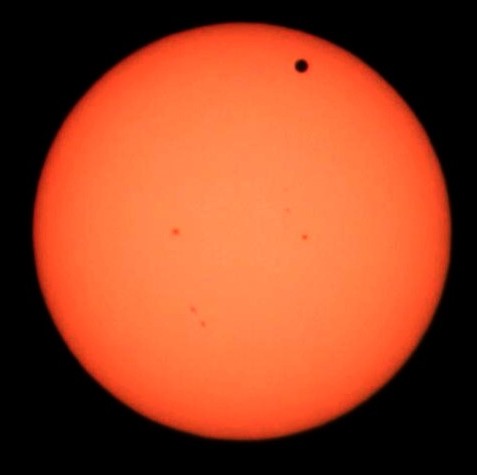
by Timothy Oleson Wednesday, June 6, 2012

Venus transits the sun on June 5, 2012. ©Tom Ruen, Creative Commons Attribution-ShareAlike 3.0 Unported
If you are reading this, chances are good that you also read one or more stories leading up to yesterday’s transit of Venus across the face of the sun. Perhaps you even followed #VenusTransit on Twitter. If you didn’t already know, you likely learned that the transit is akin to a solar eclipse — when the moon crosses directly between Earth and the sun, temporarily blocking part or all of the latter from our view — with the caveat that Venus only blacks out a small dot of the sun because of its distance from Earth.
So what was all the fuss about? What was it about the celestial equivalent of watching a marble roll slowly across a dinner plate that brought people out in droves, from professional and amateur scientists to casual observers and families with young children?
First, history has only documented a handful of such transits. And second, whereas the most recent transit of Venus (prior to yesterday) was in 2004, the next one will not occur for awhile … December of 2117 to be exact!
If you’re like me, that last part was the kicker. I am inclined to agree with Paul Sell, an astronomy graduate student at the University of Wisconsin at Madison, who told me the appeal of the transit has to do with the fact that “it’s very rare. If you say something is once-in-a-lifetime, it draws people out.” When it sunk in that neither I nor probably about 99.999 percent of the world’s population alive today would have another opportunity to see it, I penned it in on my calendar.
Rarity is interesting. It goes for sports and politics (think of a pitcher’s perfect game, or perhaps a gubernatorial recall election) as much as it does for science. What’s more, interest scales inversely with frequency. The annual Perseid or Leonid meteor showers, for example — while fascinating in their own right — don’t hold a candle to Halley’s Comet, which only comes around every 75 years or so, or, evidently, the transit of Venus. No matter their actual interest in baseball or astronomy or whatever, people want to be present for rare occasions, if only to provide a tangible backdrop for those “I remember when …” stories to come.
[As an aside, it was amusing how many news stories about the transit used the “once-in-a-lifetime” description given that there was a transit just eight years ago. Admittedly, the earlier 21st century pass didn’t make my radar at the time. Perhaps I was just not as tuned in. Or was there less interest collectively because we knew it would be back again soon?]
But is rarity all there is to it? I began to wonder if there were other, more substantive explanations, especially upon seeing the mass of prospective spectators waiting outside the University of Wisconsin’s Washburn Observatory in Madison last night to pick up special sunglasses and maybe catch a brief glimpse of the transit by way of the observatory’s 134-year-old telescope (with which astronomers viewed the last pre-21st century transit of Venus in 1882, I learned). Even after it was clear that the weather would not cooperate (stupid clouds), the line remained hundreds of people long.
A friend told me that his interest stemmed more from what these kinds of events have taught us and can still teach us about the solar system and even the space beyond. Indeed, past transits inspired some of history’s greatest scientists and explorers to try to solve some of the pressing scientific questions of their day: How big is the solar system? How far is Earth from the sun? The 2004 transit taught us new information about Venus' atmosphere. And leading up to yesterday’s event, scientists were confident that it would help reveal clues about the atmospheres of some of the exoplanets that they have been identifying — seemingly by the handful — of late. (I guess we’ll have to wait and see what pans out.)
Sell, who was enthusiastically discussing the transit and explaining Washburn’s history to the inquisitive spectators who were allowed up a few at a time to the telescope yesterday, had another explanation as well. Astronomy holds a special place with people because it is on the edge of the frontier, he said. And as for the Venus transit or similar events, “it’s a very accessible edge of the frontier for people … You can understand that Venus passes in front of the sun. It makes sense and it’s really cool to be able to see.”
So, perhaps our interest in watching Venus transit across the face of the sun is not unlike the interest that takes us to an aquarium, where fascinating mysteries of the undersea frontier are accessible. Or maybe it is because we know that someday, a textbook will detail what we learned about the cosmos from the long-past transit of 2012. Then again, perhaps for some, it is just the rarity of it. Not that there’s anything wrong with that (to borrow a line from “Seinfeld”).
For me, after contentedly watching that small black marble inch its way across the big, bright dinner plate for an hour on my home computer (thanks to several live feeds from around the world), I decided it was a bit of all three. Although I still wish I had a cool story to tell in 20 years. Stupid clouds.
© 2008-2021. All rights reserved. Any copying, redistribution or retransmission of any of the contents of this service without the expressed written permission of the American Geosciences Institute is expressly prohibited. Click here for all copyright requests.